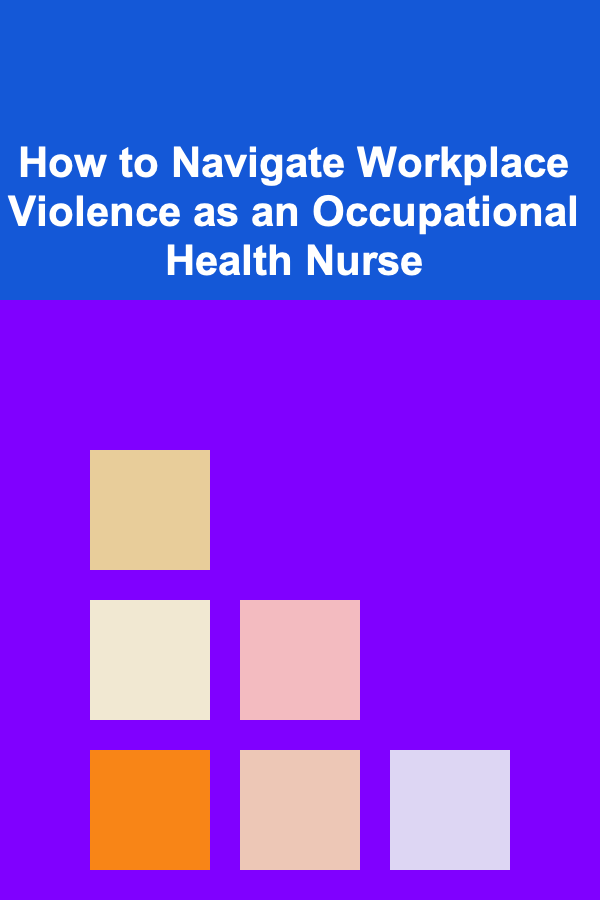
How to Navigate Workplace Violence as an Occupational Health Nurse
ebook include PDF & Audio bundle (Micro Guide)
$12.99$10.99
Limited Time Offer! Order within the next:

Workplace violence (WPV) is a growing concern in many professions, particularly for healthcare workers, including occupational health nurses (OHNs). These professionals often find themselves on the front lines of patient care, workplace safety, and regulatory compliance. As such, understanding how to navigate and manage workplace violence is critical for their personal safety and the overall well-being of the organizations they serve.
This article will explore how occupational health nurses can effectively manage, prevent, and respond to workplace violence. It will focus on understanding the types and causes of workplace violence, the risks OHNs face, and strategies for intervention, prevention, and support. Furthermore, we will delve into the necessary frameworks, policies, and tools that OHNs can utilize to minimize the impact of workplace violence in their work environments.
Understanding Workplace Violence
Workplace violence refers to any act of physical violence, threats of violence, harassment, or verbal abuse that occurs in a professional setting. In healthcare settings, where stress levels are high and resources are often stretched thin, incidents of workplace violence are a serious concern. Occupational health nurses need to understand the dynamics of workplace violence in order to protect themselves, colleagues, and patients.
Types of Workplace Violence
The Occupational Safety and Health Administration (OSHA) classifies workplace violence into four categories:
-
Type I: Criminal Intent
- This involves violence by someone who has no legitimate relationship to the workplace or its employees, such as robberies or assaults by outsiders.
- For example, a robbery at a hospital pharmacy can lead to violent interactions with staff.
-
Type II: Customer/Client/Patient
- This category includes violence directed at workers by customers, patients, or clients. It is the most common form of workplace violence in healthcare settings.
- Occupational health nurses may encounter violent patients, families, or clients who are agitated, upset, or experiencing medical crises.
-
Type III: Worker-on-Worker
- This occurs when one employee commits an act of violence against another. It may involve bullying, harassment, or physical assault among coworkers.
- Workplace conflict, workplace stress, or hierarchical issues can escalate into these types of violent incidents.
-
Type IV: Personal Relationship
- This type of violence involves someone who has a personal relationship with an employee (e.g., an ex-spouse, domestic partner) and attacks them at the workplace.
- Though this category is less common, it is still an important risk to consider in safety protocols.
Causes of Workplace Violence
Understanding the root causes of workplace violence is essential to preventing it. Several factors can contribute to violent behavior in the workplace, including:
- Job-related Stress: High demands, low staffing levels, long working hours, and emotional exhaustion can lead to frustration, increasing the likelihood of aggression.
- Mental Health Issues: In healthcare settings, patients with psychiatric conditions or those in acute distress may react violently, particularly when they feel threatened or misunderstood.
- Substance Abuse: Patients or individuals who are under the influence of drugs or alcohol may engage in unpredictable or violent behavior.
- Environmental Stressors: Poor working conditions, lack of security, or ineffective policies can contribute to violent incidents.
- Workplace Culture: A toxic work culture that tolerates bullying or harassment can create an environment where violence is more likely to occur.
The Role of Occupational Health Nurses in Addressing Workplace Violence
Occupational health nurses are in a unique position to address workplace violence, as they are responsible for ensuring both the health and safety of employees. Their role involves direct care, education, policy implementation, and collaboration with other stakeholders to mitigate risks.
Recognizing Early Signs of Violence
OHNs must be trained to recognize the early signs of workplace violence, which can include:
- Verbal Aggression: Raised voices, swearing, threats, or aggressive language.
- Non-verbal Aggression: Gestures, facial expressions, or body language that indicate anger or hostility.
- Physical Symptoms of Stress: Increased blood pressure, rapid breathing, clenched fists, or tense posture.
- Escalating Behavior: A patient or coworker who is becoming more agitated or irrational, especially if their behavior has become erratic or unpredictable.
Providing Immediate Care and Support
When an incident of workplace violence occurs, the first priority is to ensure that the individual involved receives appropriate medical attention and emotional support. OHNs must be prepared to assess injuries, provide first aid, and refer patients or employees to other medical professionals if necessary.
In cases of non-physical violence (e.g., verbal abuse), OHNs should focus on offering psychological support and helping the individual cope with the emotional stress of the incident. This could involve providing counseling, offering access to mental health resources, or facilitating debriefing sessions.
Reporting and Documentation
One of the critical responsibilities of OHNs is ensuring that workplace violence incidents are properly documented and reported. Accurate documentation is essential for ensuring that the organization can respond effectively and for legal purposes, should any litigation arise.
- Incident Reports: OHNs should encourage employees to report all instances of workplace violence, whether they involve physical injury or not. This includes documenting the time, place, and nature of the incident.
- Follow-up: After an incident, OHNs should follow up with affected individuals to ensure that they are recovering and receiving the necessary support. This can also provide an opportunity to evaluate how the incident was handled and what can be improved in the future.
Developing and Implementing Workplace Violence Prevention Policies
Prevention is the most effective way to combat workplace violence. Occupational health nurses play a vital role in developing and implementing workplace violence prevention policies, working with management, human resources, and other healthcare professionals.
Risk Assessment
A thorough risk assessment is essential for identifying workplace violence hazards. OHNs should assess the workplace environment regularly, identifying areas or situations that may put staff members at risk.
- Workplace Design: Analyze whether the physical layout of the facility contributes to safety risks. Are there isolated areas, poorly lit spaces, or obstructed escape routes?
- Employee Training: Ensure that employees are adequately trained to deal with patients or clients who may be at risk of violent outbursts. Training should include conflict resolution techniques, de-escalation strategies, and how to use personal protective equipment (PPE).
- Security Measures: Ensure that there are effective security measures in place, such as surveillance cameras, alarm systems, and trained security personnel. OHNs should work with security to ensure that the protocols are clearly communicated and followed.
Training and Education
OHNs should be involved in developing training programs for staff to increase awareness and reduce the likelihood of workplace violence. Training should cover:
- Recognizing Warning Signs: Teaching staff to identify early warning signs of aggression in patients, clients, or colleagues.
- De-escalation Techniques: Providing staff with strategies to calmly and effectively defuse tense situations before they escalate.
- Self-Defense: Offering training on non-violent methods of protecting oneself in case of an emergency. This might include techniques like verbal self-defense or situational awareness.
- Crisis Communication: Teaching staff how to communicate effectively during a crisis, whether it's calming a patient or alerting security.
Establishing Reporting Systems
A clear, anonymous reporting system should be in place to allow staff to report incidents without fear of retaliation. OHNs can advocate for such systems and ensure that they are well publicized to all employees.
- Anonymous Reporting: Employees should feel confident that they can report incidents of workplace violence without fear of judgment or reprisal.
- Clear Protocols: OHNs should work with management to develop clear reporting procedures. Employees must know who to contact, how to report incidents, and what steps will be taken afterward.
Developing a Support System for Affected Employees
The impact of workplace violence can be both physical and psychological. OHNs must ensure that employees affected by workplace violence have access to appropriate support.
- Employee Assistance Programs (EAPs): OHNs should promote the availability of EAPs, which provide confidential counseling, mental health resources, and stress management services.
- Follow-up Care: After an incident, OHNs should follow up with affected individuals to assess their well-being and provide continued support, such as referrals to mental health professionals.
- Peer Support Groups: Peer support can be vital for workers recovering from a traumatic event. OHNs can facilitate or connect employees with peer support groups that allow them to share experiences and coping strategies.
Collaborating with Other Healthcare Professionals and Stakeholders
To effectively manage workplace violence, OHNs must work in collaboration with other professionals, including management, human resources, security personnel, and fellow healthcare workers.
Creating a Multi-disciplinary Team
OHNs can form a team to address workplace violence. This team might include representatives from various departments, including security, human resources, and union representatives. Together, they can assess risks, review incidents, and improve the workplace environment.
Engaging with Leadership
Effective prevention requires the buy-in and active involvement of leadership. OHNs must work closely with organizational leadership to ensure that workplace violence prevention is a priority and that adequate resources are allocated.
Conclusion
Workplace violence is a complex issue that requires a proactive and multi-faceted approach. As healthcare professionals and advocates for employee well-being, occupational health nurses play a critical role in preventing and responding to workplace violence. By recognizing the risks, implementing effective prevention policies, training staff, and providing ongoing support, OHNs can significantly reduce the impact of workplace violence and create a safer work environment for all employees.
By fostering a culture of safety and addressing workplace violence head-on, OHNs not only protect their colleagues but also contribute to the overall health and productivity of the organization.
Reading More From Our Other Websites
- [Organization Tip 101] How to Create a Kid-Friendly Pantry Setup
- [Personal Care Tips 101] How to Choose Hand Cream for Sensitive or Allergic Skin
- [Organization Tip 101] How to Create a Personal Giving Mission Statement
- [Organization Tip 101] How to Use Clear Storage Bins for Efficient Organization
- [Organization Tip 101] How to Use Labels for a Tidy Kitchen Drawer System
- [Personal Investment 101] Passive Income Strategies for Deep Learning Developers
- [Home Budget Decorating 101] How to Decorate a Small Apartment on a Tiny Budget
- [Stamp Making Tip 101] Design Secrets: Translating Your Art into Perfect Linoleum Stamps
- [Home Space Saving 101] How to Store Your Belongings Efficiently in a Small Closet
- [Star Gazing Tip 101] Safe Starlight: Essential Tips for Nighttime Sky Watching

How to Create a Backyard Camping Experience for the Family
Read More
How to Use Task Lighting to Improve Productivity in Your Home Office
Read More
How To Understand Unspoken Cultural Rules
Read More
How to Lead and Motivate Your Team: A Comprehensive Guide
Read More
How to Use a Yoga Planner for Goal Setting in Yoga
Read MoreHow to Build a Custom Bank Fee Expense Tracker in Excel
Read MoreOther Products

How to Create a Backyard Camping Experience for the Family
Read More
How to Use Task Lighting to Improve Productivity in Your Home Office
Read More
How To Understand Unspoken Cultural Rules
Read More
How to Lead and Motivate Your Team: A Comprehensive Guide
Read More